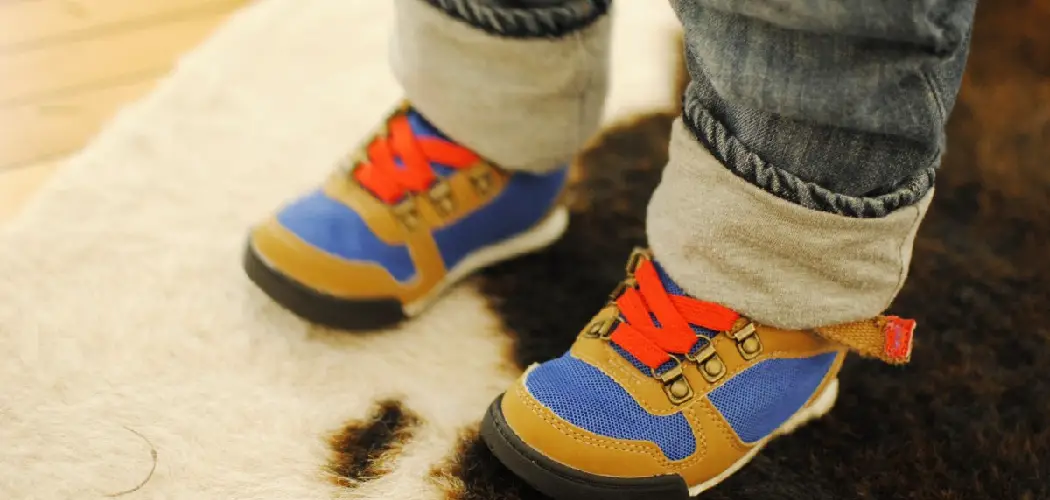Ensuring that children wear properly fitting shoes is crucial for their foot health and overall comfort. Ill-fitting footwear can lead to many foot problems, from blisters and calluses to more severe structural issues affecting a child’s gait and posture. Understanding how to measure a child’s shoe size accurately is the first step towards protecting their feet.
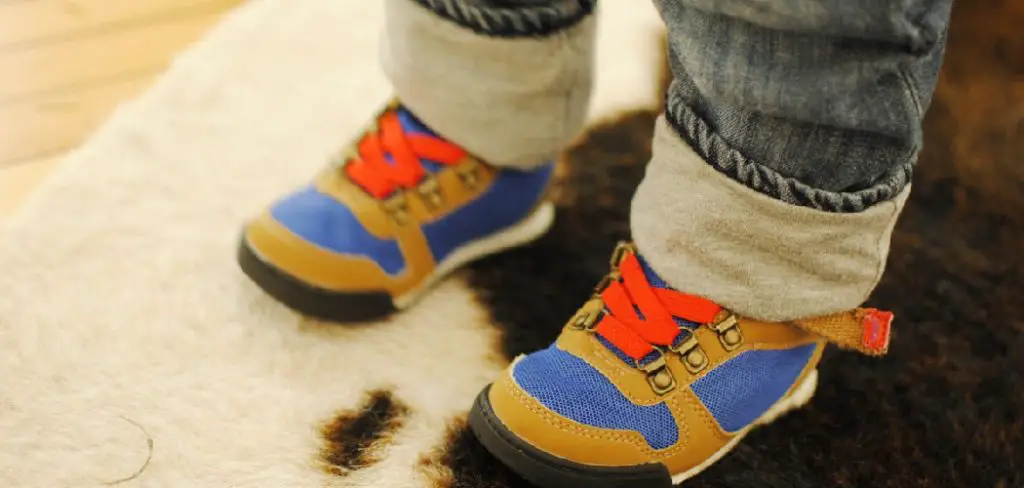
Precise measurement is indispensable because children’s feet grow unpredictably, and what fits one month might become uncomfortably tight the next. This guide is dedicated to teaching parents and guardians the correct method of measuring their child’s foot size. By following these step-by-step instructions, including the keyword “how to measure child’s shoe size,” you will be able to select shoes that fit well, providing your child with the necessary support as they explore and learn through their daily activities.
Gather Materials
Before you begin measuring your child’s feet for their new shoes, gathering all the necessary materials is essential. Ensuring you have these items on hand will make the process smoother and more accurate.
A. Shoe Sizing Chart
The first thing you’ll need is a standard shoe sizing chart. These charts are readily available online and can be downloaded and printed at home. A shoe sizing chart is a reference for translating foot measurements into the corresponding shoe size. When selecting a chart, make sure it’s specific to children’s shoe sizes, as adult and children’s sizes follow different scales.
B. Measuring Device
You’ll need an appropriate measuring device to accurately measure your child’s foot length and width. The most professional tool for this is a Brannock Device, which is often found in shoe stores. However, if you measure at home, a shoe sizer or a printable foot-measuring tool can also do the job. Printable measuring tools can be found online and offer a convenient and cost-effective way to accurately measure your child’s feet. Ensure that the printing scale is correct to maintain measurement accuracy.
C. Pen or Marker
Having a pen or marker is crucial to mark the measurement on the device once you’ve aligned your child’s foot properly. This step is important because it allows you to transfer the measurement accurately from the device to the sizing chart. Ensure the pen or marker works well to make clear, visible marks.
Gathering these materials in advance will prepare you for a successful measuring session, ensuring you find the perfect fit for your child’s shoes.
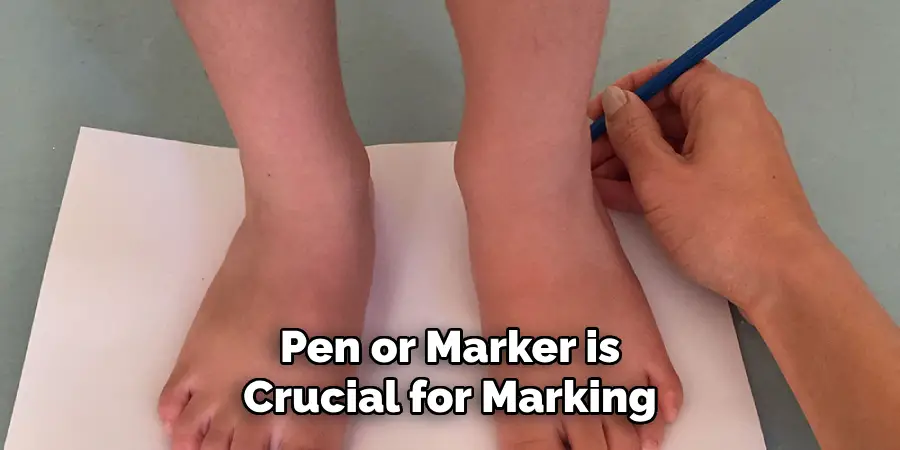
How to Measure Child’s Shoe Size: Measure the Foot Length
Measuring your child’s foot length is a straightforward but critical step in determining the correct shoe size. The accuracy of this measurement influences the fit and comfort of the shoes, ensuring that your child can move naturally and without any restrictions. Follow these steps to measure the foot length accurately:
A. Place the Foot on the Measuring Device
Begin by having your child stand on the measuring device with their weight distributed evenly on both feet. It’s essential that the foot being measured is flat on the surface, ensuring that the heel is aligned with the back edge of the device. This alignment is crucial for an accurate measurement, as positioning the foot too far forward or back on the device can lead to selecting the wrong shoe size.
B. Align the Longest Toe
Next, identify the longest toe, which is typically the big toe, but not always. Gently press the longest toe towards the front edge of the measuring device. This action helps in getting the maximum length of the foot, which is necessary when choosing the correct shoe size. Remember, the goal is to ensure comfort, particularly in the toe box area of the shoe, to allow for natural toe movement.
C. Read the Measurement
Once the foot is properly positioned and the longest toe is aligned, take note of the measurement indicated at the end of the longest toe. This reading will tell you the precise length of your child’s foot. It’s advisable to measure both feet, as it’s common for one foot to be slightly larger than the other. Use the measurement from the larger foot when selecting a shoe size to guarantee a comfortable fit.
Accurately measuring foot length is a vital step in measuring a child’s shoe size. This measurement is the foundational piece of data you’ll use to select the appropriately sized shoe. With the correct foot length determined, you’re one step closer to finding shoes that support healthy foot development and enable your child to engage in playful activities without discomfort.
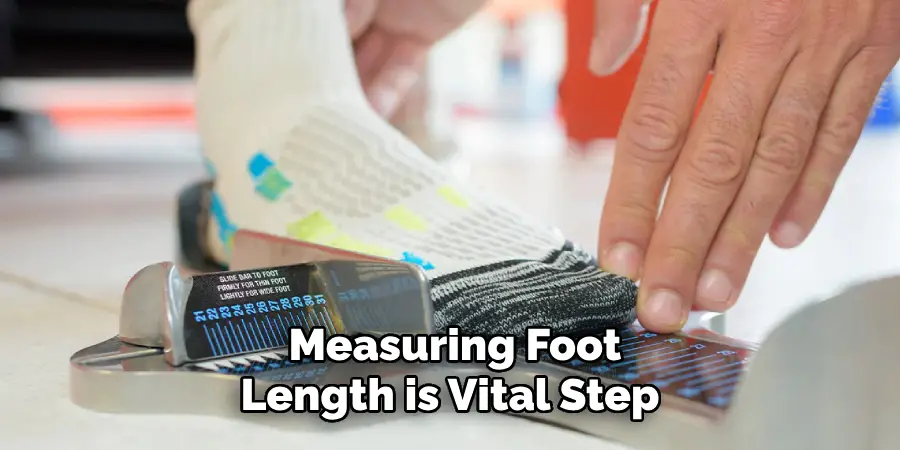
How to Measure Child’s Shoe Size: Measure the Foot Width
Measuring the foot width is equally important as determining the foot length to ensure the shoes fit comfortably and do not constrict the feet. Shoes that are too narrow can cause blisters, calluses, and discomfort, while shoes that are too wide will not provide adequate support. Here is how to accurately measure the width of your child’s foot.
A. Use the Widest Part of the Foot
To start, you will need to identify and measure the widest part of the foot, which is typically the ball of the foot. Place the foot so that this area is directly above the widest part of the measuring device. This part of the process is crucial for ensuring that the shoes will accommodate the natural spread of the foot when walking or running.
B. Ensure Proper Alignment
Ensure the foot is positioned straight and parallel to the measuring device for an accurate width measurement. Proper alignment is key to precisely measuring the foot’s width. The foot should not be angled or skewed on the measuring device, as this can result in an incorrect reading. Ensuring the foot is fully flat and aligned allows for a true measure of foot width at its widest point.
C. Read the Width Measurement
Once the foot is properly aligned at its widest point on the measuring device, look for the width indication. This will typically be marked in letters (A, B, C, D, E, EE, etc., with A being very narrow and EE being very wide) or numerically. Record this width measurement reading. It is essential to measure both feet as slight differences between the two may exist. Always consider the wider measurement when choosing shoe width to ensure maximum comfort and proper fit.
By carefully measuring the length and width of your child’s feet, you can significantly increase the likelihood of purchasing well-fitted shoes supporting healthy foot development. Accurate width measurements are particularly important for children with wider or narrower feet than average, ensuring they can enjoy daily activities comfortably and easily. This attention to detail in selecting shoes not only contributes to comfort but also encourages proper foot development and minimizes the risk of foot-related issues.
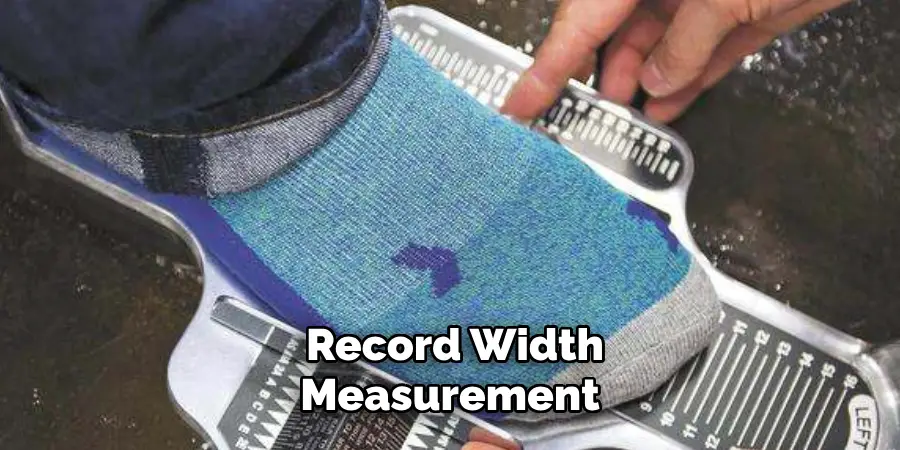
How to Measure Child’s Shoe Size: Determine the Shoe Size
Once you have accurately measured the length and width of your child’s feet, the next crucial step is determining the correct shoe size. This involves a process that requires attention to detail and consideration of several factors to ensure a perfect fit. Here are the steps to take in determining your child’s shoe size:
A. Refer to the Sizing Chart
With the recorded measurements of your child’s foot length and width in hand, the next step is to consult the shoe sizing chart available with the shoe brand or retailer. Shoe sizing charts typically list sizes according to length and width measurements. Locate the chart section corresponding to your child’s foot measurements to find the appropriate shoe size. It’s important to remember that the sizing chart serves as a guide and starting point in selecting the right size.
B. Consider Brand Variations
It’s essential to recognize that shoe sizes may vary between different brands due to their unique sizing standards and the design of their shoes. Some brands may run smaller or larger than others. Thus, when you have determined a size based on a generic or specific brand’s sizing chart, it is advisable to refer to each brand’s specific sizing guide before making a purchase. This step is crucial for ensuring that the shoes fit comfortably and correctly according to the brand’s unique sizing.
C. Account for Growth Room
Children’s feet grow at a rapid pace, and it is important to select shoes that accommodate this growth to prevent discomfort and the need for frequent replacements. A good rule of thumb is to leave about a half inch (or a thumb’s width) of extra space between the longest toe and the front of the shoe. This additional space ensures there is enough room for growth and allows for natural foot movement. It is a balance between providing room for growth while ensuring the shoes are not too large, which could lead to a lack of support and potential tripping hazards.
By carefully considering these factors – consulting the sizing chart, considering brand variations, and accounting for growth room – you will be well on your way to choosing a shoe that offers both comfort and support for your child’s developing feet. Remember, well-fitted shoes play an essential role in the healthy development of children’s feet and their overall posture and movement.
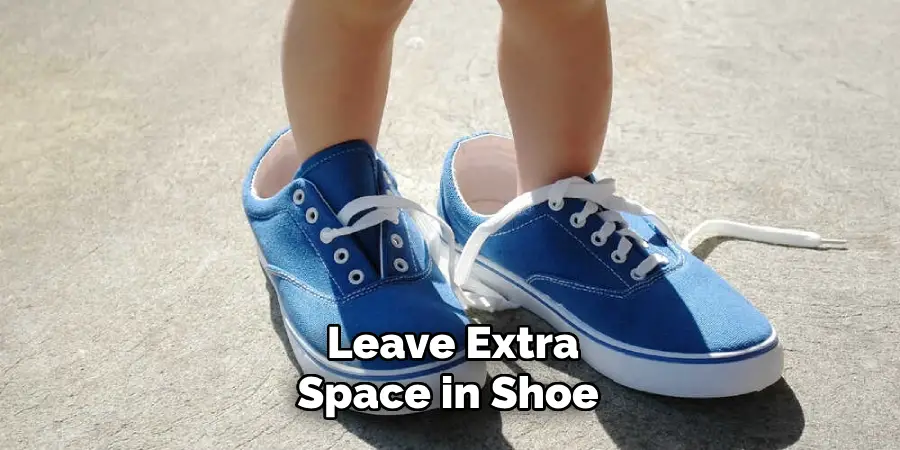
Try on Shoes
After determining your child’s shoe size through careful measurement and consultation with sizing charts, the next vital step is the actual fitting process. This phase is crucial because even with accurate measurements, the true test of a shoe’s suitability comes from how it feels on the foot. Here are the steps to ensure the shoes you’ve selected are the perfect fit for your child.
A. Test the Fit
Have your child try on the shoes with the type of socks they’ll typically wear. Shoes should be tried on both feet, as there can be slight differences in foot size. Ensure that the heel sits snugly against the back of the shoe without slippage. The child should indicate whether the shoe feels too tight, loose, or right. The aim is to find a shoe that fits comfortably without ” breaking it in”.
B. Check for Comfort
Check that there is enough room at the front of the shoe for your child’s toes. There should be approximately a half inch of space between the front of the shoe and the longest toe to allow for toe movement and growth. The shoe should feel secure but not constricting, providing enough width to not squeeze the sides of the feet while holding the heel in place firmly. Encourage your child to express how their feet feel in terms of tightness, pressure points, or any discomfort.
C. Walk Around
Encourage your child to walk around the store or room for a few minutes. Pay attention to their gait and ask them to describe how the shoes feel. The shoes should offer stability and flexibility, supporting natural foot movement without causing any strain. Look out for any signs of discomfort such as limping or complaints about specific areas of the shoe rubbing against their foot. It’s also an opportunity to notice if the shoes provide the necessary arch support, which is paramount for developing feet.
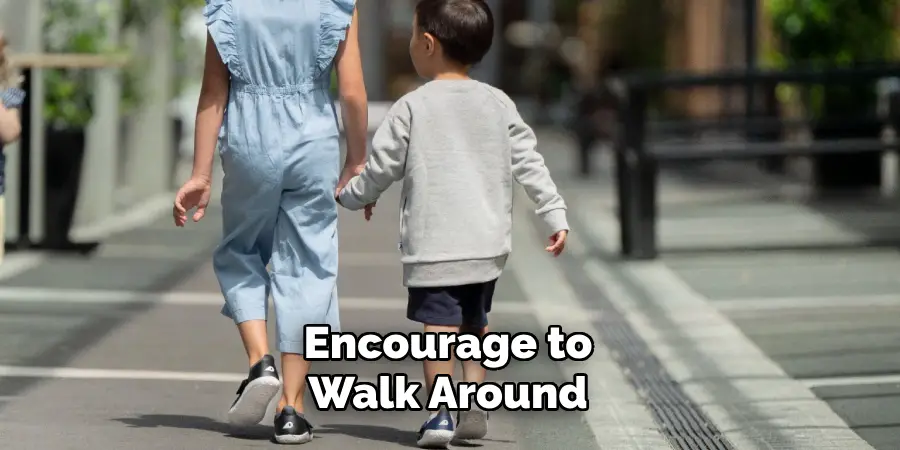
Remember, children may not always communicate discomfort or might think they can ‘get used to’ a tight or awkward shoe fit, so it’s important for the caregiver to be observant and ask specific questions about how the shoes feel. A good fit now prevents foot problems later, making this step arguably one of the most important in selecting the right shoes for your child.
Reassess Regularly
Ensuring your child wears shoes that fit correctly is an ongoing process due to their rapid growth and development. Here are two essential strategies to maintain the perfect shoe fit for your child:
A. Monitor Growth
During growth spurts, children’s feet can grow quickly and sometimes unevenly. It’s crucial to check your child’s shoe size every few months to ensure they still fit properly. A shoe that was once comfortable can become tight and restrictive, leading to discomfort or even foot problems. Regularly measuring your child’s feet against a sizing chart can help you stay ahead of these growth spurts and ensure their shoes are always of the correct size.
B. Adjust as Needed
Be flexible and prepared to adjust your child’s shoe size based on their current growth and development. This may mean purchasing new shoes more frequently than expected, but it is vital for maintaining their foot health and comfort. Pay attention to signs that shoes are becoming too small, such as difficulty putting them on, complaints of tightness, or visible signs of wear and pressure. Adjusting shoe size and style as your child grows is key to supporting their foot health and overall well-being.
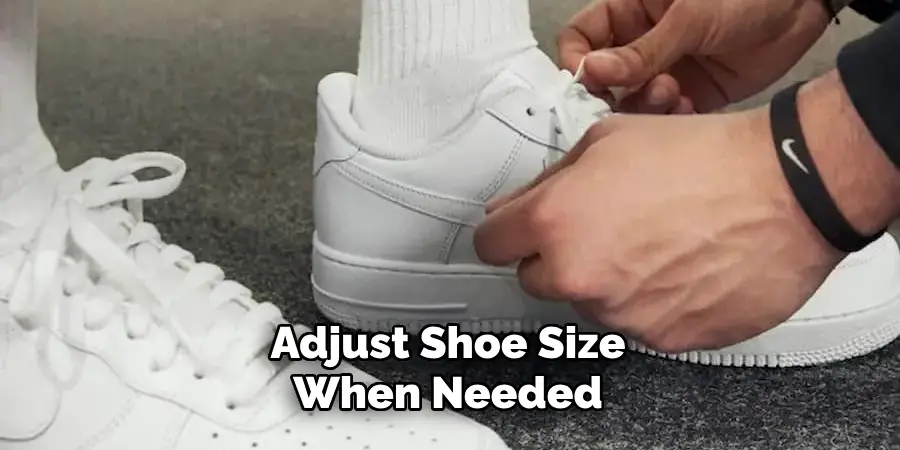
Frequently Asked Questions (FAQs) about Children’s Shoe Sizing
Q1: How often should I measure my child’s feet?
A1: It is recommended to measure your child’s feet every three to four months as children’s feet grow rapidly. Regular measurements ensure that you keep pace with their growth and change shoe sizes as needed.
Q2: Can I determine my child’s shoe size at home, or do I need to have it professionally measured?
A2: While having your child’s feet measured by a professional at a shoe store is ideal for accuracy, you can also measure their feet at home using a ruler and a sizing chart available online. Ensure you follow the instructions carefully for the best results.
Q3: What is the best time of day to measure my child’s feet?
A3: The best time to measure your child’s feet is in the afternoon or evening. Feet tends to swell slightly throughout the day, so measuring later ensures that the shoes will fit comfortably at any time.
Q4: Should I buy shoes a size bigger for my child to grow into?
A4: While it’s important to account for growth, shoes that are too large can be just as harmful as shoes that are too small. They can cause tripping and may not provide the necessary support. Aim for about a half inch of extra space beyond the longest toe for growth, but no more.
Q5: How do I know if my child’s shoes no longer fit correctly?
A5: Signs that your child’s shoes are too small include difficulty in putting them on, complaints about tightness or discomfort, visible signs of pressure on the foot (like red marks), and their toes pressing against the front of the shoe. Regularly check their feet and shoes for these signs to ensure they always wear shoes that fit well.

Conclusion
In conclusion, the process of finding the perfect fit for your child’s shoes involves a series of critical steps. Starting with how to measure child’s shoe size, we’ve covered the importance of consulting sizing charts, accounting for brand variations, and ensuring there’s growth room. Accurate measurement and regular monitoring are paramount for maintaining proper foot health and comfort.
By diligently following these guidelines, you can significantly enhance your child’s walking and playing experiences. Remember, a shoe that fits well supports healthy foot development and prevents potential foot problems. Encourage your child to share how their shoes feel and reassess their shoe size regularly to ensure they always have the support they need. Your commitment to applying these principles will pave the way for your child’s happy, healthy feet.

